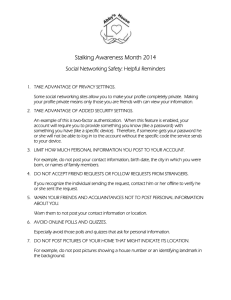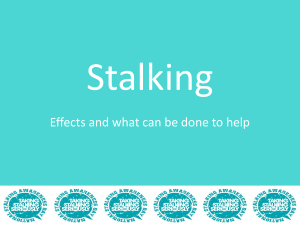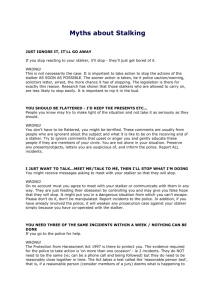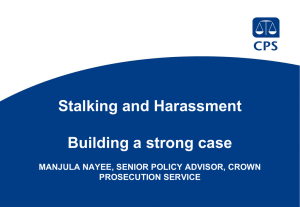VICTIM EYES
advertisement
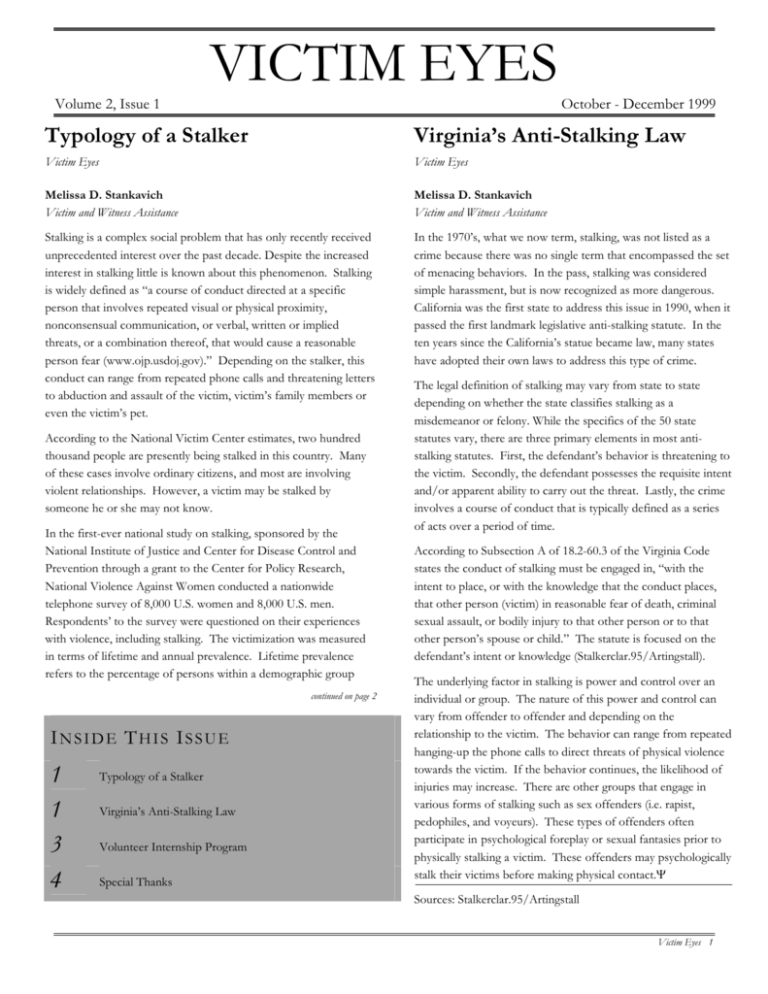
VICTIM EYES Volume 2, Issue 1 October - December 1999 Typology of a Stalker Virginia’s Anti-Stalking Law Victim Eyes Victim Eyes Melissa D. Stankavich Victim and Witness Assistance Melissa D. Stankavich Victim and Witness Assistance Stalking is a complex social problem that has only recently received unprecedented interest over the past decade. Despite the increased interest in stalking little is known about this phenomenon. Stalking is widely defined as “a course of conduct directed at a specific person that involves repeated visual or physical proximity, nonconsensual communication, or verbal, written or implied threats, or a combination thereof, that would cause a reasonable person fear (www.ojp.usdoj.gov).” Depending on the stalker, this conduct can range from repeated phone calls and threatening letters to abduction and assault of the victim, victim’s family members or even the victim’s pet. In the 1970’s, what we now term, stalking, was not listed as a crime because there was no single term that encompassed the set of menacing behaviors. In the pass, stalking was considered simple harassment, but is now recognized as more dangerous. California was the first state to address this issue in 1990, when it passed the first landmark legislative anti-stalking statute. In the ten years since the California’s statue became law, many states have adopted their own laws to address this type of crime. According to the National Victim Center estimates, two hundred thousand people are presently being stalked in this country. Many of these cases involve ordinary citizens, and most are involving violent relationships. However, a victim may be stalked by someone he or she may not know. In the first-ever national study on stalking, sponsored by the National Institute of Justice and Center for Disease Control and Prevention through a grant to the Center for Policy Research, National Violence Against Women conducted a nationwide telephone survey of 8,000 U.S. women and 8,000 U.S. men. Respondents’ to the survey were questioned on their experiences with violence, including stalking. The victimization was measured in terms of lifetime and annual prevalence. Lifetime prevalence refers to the percentage of persons within a demographic group continued on page 2 INSIDE THIS ISSUE 1 1 3 4 Typology of a Stalker Virginia’s Anti-Stalking Law Volunteer Internship Program Special Thanks The legal definition of stalking may vary from state to state depending on whether the state classifies stalking as a misdemeanor or felony. While the specifics of the 50 state statutes vary, there are three primary elements in most antistalking statutes. First, the defendant’s behavior is threatening to the victim. Secondly, the defendant possesses the requisite intent and/or apparent ability to carry out the threat. Lastly, the crime involves a course of conduct that is typically defined as a series of acts over a period of time. According to Subsection A of 18.2-60.3 of the Virginia Code states the conduct of stalking must be engaged in, “with the intent to place, or with the knowledge that the conduct places, that other person (victim) in reasonable fear of death, criminal sexual assault, or bodily injury to that other person or to that other person’s spouse or child.” The statute is focused on the defendant’s intent or knowledge (Stalkerclar.95/Artingstall). The underlying factor in stalking is power and control over an individual or group. The nature of this power and control can vary from offender to offender and depending on the relationship to the victim. The behavior can range from repeated hanging-up the phone calls to direct threats of physical violence towards the victim. If the behavior continues, the likelihood of injuries may increase. There are other groups that engage in various forms of stalking such as sex offenders (i.e. rapist, pedophiles, and voyeurs). These types of offenders often participate in psychological foreplay or sexual fantasies prior to physically stalking a victim. These offenders may psychologically stalk their victims before making physical contact.Ψ Sources: Stalkerclar.95/Artingstall Victim Eyes 1 continued from page 1 who were stalked sometime in their life-span, where annual prevalence occurred sometime during the 12 months preceding the survey. Table One: Victim's Age When First Stalked The study found that ninety percent of the victims of stalking were stalked by just one person during their life-span, where as, nine percent of female and eight percent of male victims were stalked by two different persons. In cases where three different stalkers were involved, it is estimated that one percent of female and two percent of male were classified as victims of this stalking. The study further indicated that the age group most at risk of being stalked was between the ages of eighteen and thirty-nine (See Table One). 22% 30-39 Years 18-29 Years >40 Years 51% 15% <18 Years 12% Souce: www.ojp.usdoj.gov Table Two: Relationship Between Victim and Offender 38 23 Male Female Stranger 2 4 Acquaintance 10 Date / Former Date 9 10 19 14 Realtive Other than Spouse 13 36 34 Cohabiting Partner / Expartner 40 35 30 25 20 15 10 5 0 Spouse / Exspouse Percentage of Cases Though stalking is a gender-neutral crime, women were found to be the primary victims and men were the primary perpetrators of stalking. The survey also confirmed that most victims know their stalkers (See Table Two), and link stalking and other forms of violence in intimate relationships. Eighty-one percent of the women who were stalked by a current or former husband or cohabiting partner were physically assaulted, and thirty-one percent were sexually assaulted. Twenty percent of the women who were ever married or lived with a man were physically assaulted by a current or former husband or partner and five percent were sexually assaulted. Thus, husbands or partners who stalk their significant other are four times more likely than husbands or partners in the general population to physically assault their significant other, and six times more likely to sexually assault their significant other (www.ojp.usdoj.gov). The survey, further, demonstrates a link between stalking and controlling and emotionally abusive behavior in intimate relationships. Respondents’ to the survey were asked a series of questions about their experiences of controlling and emotionally abusive behavior inflicted by their current or former spouses or cohabiting partners. The study reported that partners who stalked their significant others where more likely to engage in emotionally abusive and controlling behavior towards their significant other than those partners who do not engage in stalking behaviors. Respondents to the study also indicated that stalking typically occurs at the end of a relationship (See Table Three). When respondents were asked to describe specific activities or behaviors their stalkers engaged in to harass and terrorize them, women were more likely to report that their stalkers followed, spied, or stood outside their home, work, or recreation. Women also reported that their stalkers made unsolicited phone calls. However, both men and women report their stalkers sent unwanted letters or other items, vandalized their property, or killed or threatened to kill a family pet. Table Three: Point in Intimate Relationship When Stalking of Women Occurs 21% Before Relationship Ends 43% After Relationship Ends 36% Source: www.ojp.usdoj.gov Both Before and After Relationship Ends Table Four: Distribution of Cases by Nuber of Years Stalking Lasted 9% 5+ Years The study further indicated that at the time of the interviews ninetytwo percent of the victims were no longer being stalked (See Table Four). However, one thing professionals have determined is that many obsessive personality types, including stalkers, do not lose interest and may poses an ever-growing threat to the objects of their obsessions. Sometimes there are obvious warning signs, such as a 16% 1 Year <1 Year 2-5 Years 52% 23% Source: www.ojp.usdoj.gov Continued on page 3 Victim Eyes 2 VOLUNTEER INTERNSHIP PROGRAM (VIP) THE PURPOSE OF THE VOLUNTEER INTERNSHIP PROGRAM IS TO PROVIDE STUDENTS, WHO DESIRE A CAREER WITHIN THE CRIMINAL JUSTICE SYSTEM, THE OPPORTUNITY TO APPLY THEIR KNOWLEDGE AS A VICTIMS’ ADVOCATE WITHIN THE JUDICIAL SYSTEM. BY APPLYING THEORIES AND TECHNIQUES LEARNED WITHIN THE EDUCATIONAL SETTING TO REDUCE THE TRAUMA OF VICTIMIZATION AND ENCOURAGE VICTIMS TO COOPERATE WITH AND PARTICIPATE IN THE CRIMINAL JUSTICE SYSTEM BY PROVIDING DIRECT SERVICES, INCLUDING INFORMATION AND ASSISTANCE BEFORE, DURING, AND AFTER THE COURT PROCEEDINGS. FOR MORE INFORMATION REGARDING THE VOLUNTEER INTERNSHIP PROGRAM CONTACT MELISSA STANKAVICH , MONDAY THROUGH FRIDAY BETWEEN 9:00 A.M. AND 5:00 P.M. AT (757) 357-7403. continued from page 2 series of threatening letters or messages left on an answering machine. Other times there may be no obvious clues that a crime has been committed. The stalkers’ weapons of choice are not items normally considered menacing, for examples, leaving gifts on the doorstep or at work. However, these things can be a prelude of what’s yet to come. Victims of stalking often recognize that something is wrong before anyone else. According to John Douglas’s and Mark Olshaker’s book, Obsession, most stalkers are in their late teens and early twenties, and characterized as having above-average intelligence. Stalkers are also typically characterized as lonely people, often socially withdrawn, and may have a closer relationship with the television than with other human beings. Some stalkers never had close personal relationships or sex, and have no immediate prospects of either. Although specific behaviors and characteristics exhibited by stalkers vary widely, these characteristics have been categorized into four typologies: Erotomania Stalker, Nuisance Stalker (Loveobsession stalker), Simple-obsession Stalker (Domestic Stalker), and False Victimization Syndrome. The Erotomania Stalker is a relatively rare phenomenon only representing eight percent of all cases. Approximately eighty-five percent of erotomanic stalkers are females between the ages of thirty through forty years of age. This stalker is motivated by an offender-victim relationship that is based on the stalker’s fixation. The fantasy the stalker has about the victim is expressed through fusion or by blending the stalker’s personality with the victim’s. The other type of fantasy is erotomania, which refers to a fantasy base idealized romantic love or spiritual union with the victim. This preoccupation with a victim can consume and ultimately lead to death. The stalker can also be motivated by religious fantasies or voices directing the stalker to target a particular individual, unusually someone unattainable to the stalker. However, the erotomania stalker’s drive to stalk originates from a variety of motives ranging from rejection to internal conflict stemming from the stalker’s fusion with the victim. The stalker’s victims typically have high media visibility, however, other victims may include superiors at work or a complete stranger, as long as the stalker perceives the victim as someone with higher statue. In addition, unbeknownst to the victim, he/she has becomes the imagined lover of the stalker through hidden messages known only to the stalker. The stalker builds an elaborate fantasy around this imagined lover. The fantasy for a male erotomania tends to act out his fantasy with great force. For example, the actress Rebecca Shaeffer, the Star of the TV series “My Sister Sam “, was stalked by Robert Bardo for over two years. Bardo fantasized of someday marrying Shaeffer. He sent letters to her fan club and he claimed Shaeffer responded to him, which perpetuated the relationship. Bardo had gone to the studio with gifts for Shaeffer, only to be turned away. Bardo even paid a private investigator to locate Shaeffer’s home address, and he went to the residence where she answered a knock at the door. Soon after, Bardo would return and told Shaeffer that “I forgot to give you this.” then shot her in the chest with a handgun. Later, Bardo would state that Shaeffer acted like she was too good for him during his initial visit. The Nuisance Stalker or Love-obsession stalkers’ represent thirty of all stalking cases. Ninety-seven percent of the stalkers typically are males, and their victims usually are females that have no knowledge of the stalker’s identity. The age range of the stalker tends to be between the ages of thirty and forty, and their victims tend to be much younger, ranging from twenty to thirty years in age. The stalker targets the victim and interacts with the victim through obscene or harassing telephone calls, and other forms of communications or physical appearances. The relationship between the stalker and the victim is one-way. The stalker is unknown to the victim until the stalker identity can be established. For instance, a man who was stalking a woman was arrested outside her home. The police searched the stalker’s vehicle where they located a knife and keys to the victim’s residence. In addition, a .22 caliber pistol, binoculars, two tape recorders, flashlights, pictures of the victim’s residence and car, rubber and cotton gloves, a mask, a nylon bag with a change of clothes, and several condoms where found. Located in a book were pictures of the woman nude. The stalker also had a gun cleaning kit and a cooler filled with ice and beer. However, months prior to this incident, the stalker was acquitted of burglarizing the woman’s apartment. The woman informed Continued on page 4. Victim Eyes 3 Continued from page 3. police that recently her bathing suit was taped to the car’s windshield, and on another occasion she found her undergarments draped on the car’s mirror. One week prior to the stalker arrest the victim found cartridge casings from the handgun taped to the car’s window. The Simple-obsession stalker or Domestic stalker represents sixty percent of stalking cases. This type of stalker tends to be a former boyfriend or girlfriend, family or household member threatening or harassing by another member of the household. This may also included common-in-law and long-term acquaintance relationships. The victim is aware of the stalking and may have requested a restraining order or prior assistance from law enforcement. Usually, there is also a prior history of abuse, and forensic findings consistent with a personal type of assault. Alcohol and/or drugs maybe involved in these incidences, in addition to a weapon being brought to the crime scene. Generally, there is only one crime scene and it reflects the disorder and impulsive nature of the stalker and escalation of violence. To illustrate, a twenty-two year old, female broke-up with her boyfriend and had a new boyfriend. The former boyfriend sent her numerous notes and letters, constantly telephoned her and left flowers on her car, moreover, the former boyfriend threatened that no one else would ever have her. The victim and the new boyfriend encountered the former boyfriend at the gas station, where the two men yelled and scuffled with each other, and the couple left the gas station only to be followed by the former boyfriend. The former boyfriend bumped the car then sped away as the couple pulled off to the side of the road. The boyfriend left the girlfriend in the car, and went for help. The former boyfriend returned at high speed and slammed head-on into the car, killing the stalking victim. Finally, there is the False Victimization SPECIAL THANKS… The Victims’ Advocate would like to give Special Thanks and recognition to Major Hines, Deputy John Heisler, Scott Bachman, Larry Willis, and the Smithfield YWCA for their assistance in loading and unload materials used for the support groups. The Isle of Wight County Victim and Witness Assistance Program would like to give a Special Thanks and recognition to Sarah Thorn of the H.E.R.S. Shelter and intern, Jessica Smith, for speaking to the Task Force regarding the Domestic Violence Safety Project. The Victim and Witness Assistance Program would like to give Special Thanks and recognition to Mel Bass for his assistance and coordinating efforts in locating volunteers to stuff the Domestic Violence Packets. In addition to Trissy Taliaferro, who volunteered her time to stuffing the Domestic Violence Packets. Syndrome, which is the rarest, represent only two percent of all cases. These are individuals with a conscious or subconscious . desire to be placed in the role of victim byinsisting that someone is stalking them. The stalker becomes the victim. This classification appears to be similar to Munchaunen Syndrome of Proxy, which means that the offender harms a victim, then seeks medical assistance for the victim, usually a child of the female offender, in order to draw attention from the offender. As suggested in the above case studies, because most stalkers follow a pattern of behaviors these behaviors are predictable to a certain extent. However, no one professional can state exactly what a given offender will or will not do. Most will attempt to win the victim over with objects of their affection, such as gifts, love letters, and flowers. At this stage, the stalker hopes that by demonstrating or pursuing the victim, the victim will be won over. This is the motive in the case where the stalker has had a previous relationship with the victim; where the stalker’s hope to reestablish a relationship. If this fails and the stalker is rejected, the stalker will use more aggressive means, such as intimidation through harassment or threats. When intimidation tactics do not work the stalker may become homicidal and/or suicidal out of desperation and is willing to try anything to prove his love. At this point the stalker may determine that “IF I CAN NOT HAVE YOU NOBODY WILL…”Ψ Sources: Douglas, John and Olshaker, Mark, Obsession (New York: Pocket Books, 1998) pgs 274-363 www.ojp.usdoj.gov Victim and Witness Assistance would like to give a Special Thanks to Response-Peninsula continuous dedicated efforts and support of the Sexual Assault and Domestic Violence Support Groups. In addition to the Isle of Wight County YMCA for their dedicated and supportive efforts by providing the conference area and use of their childcare facilities during the Domestic Violence Support Group. Victim and Witness Assistance would like to give a Special Thanks to William Bounds for his vigorous efforts on designing a directory. The Victim and Witness Assistance Program would like to give a Special Thanks to Anita Barba for translating the initial letter and flyers to Spanish. This will enable Spanish speaking victims’ the opportunity to obtain information despite the language barrier. Victim Eyes 4 Victim Eyes 5
